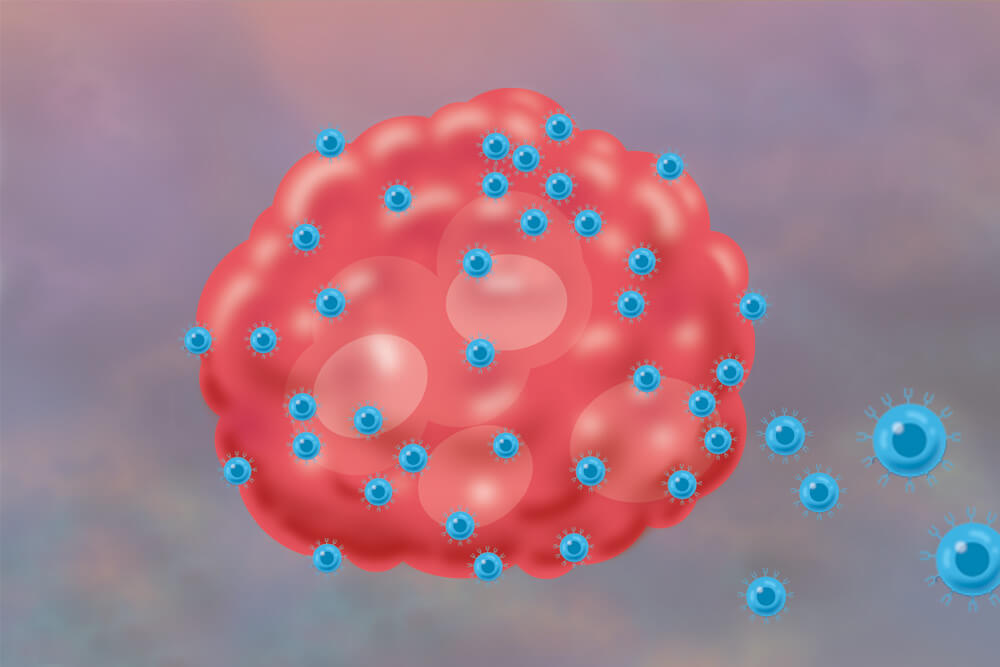Key Takeaways:
- Research reveals how some melanoma tumors prompt CD4+ T cells in their midst to de-escalate an immune system attack.
- Finding sheds light on the complex interplay between melanoma cells and T cells in the tumor microenvironment.
Like a fugitive from justice, cancer cells stake their survival on their ability to remain inconspicuous. In many cases, however, they are decked out in molecules – called tumor-associated antigens and neoantigens – that shout “cancer!” to the immune system and prompt a potent antitumor response.
But tumor cells have other means of dodging an attack. To a degree that any band of outlaws would envy, tumors are often able to manipulate the strength and scope of the immune reaction, orchestrating the mix of T cells that converge on them.
In a new study, Dana-Farber scientists have uncovered one such tumor-survival tactic. Writing in the journal Nature, they show how certain types of melanoma cells – bristling with neoantigens – can turn their susceptibility to an immune attack into an advantage and use it to and tame the forces arrayed against them.
The finding provides insight into the complex interplay between tumor cells and the immune system T cells in their midst – their microenvironment. Understanding this process will give researchers a better idea of how these interactions can affect cancer therapy, potentially strengthening or weakening it. Physicians would then be able to use this information to maximize the effect of treatment for individual patients.
Looking for the helpers
The new study focused on CD4+ T cells, best known as T “helper” cells because they assist the immune system by switching on other immune cells such as CD8+ T cells, which can kill diseased cells, and B cells, which produce antibodies. They also play a role in suppressing the immune response when needed.
“We know that melanoma tumors are often infiltrated by CD4+ T cells,” says Dana-Farber’s Catherine J. Wu, MD, who led the study with postdoctoral fellow and instructor Giacomo Oliveira, PhD. “Even when this is the case, it isn’t always clear why they’re there: many of them might be targeting tumor cells, but others might be reactive to other cells or to viruses. In this study, we asked, What is the nature of these T cells: which are actually tumor-reactive, and what does that tell us about the tumor itself?”
The researchers had good reason to think the CD4+ T cells in the microenvironment are not a uniform lot. Their previous study of CD8+ T cells, aka “killer T cells,” in melanoma tumors found some of them to be “exhausted” – able to recognize tumor cells but unwilling to attack them – and some to be non-exhausted memory cells, which had encountered melanoma cells before and were ready to take them on again.
The current study took the same approach, but with a focus on CD4+ T cells. An analysis of melanoma tissue from four patients found groups of exhausted cells and non-exhausted memory cells, but also a contingent of regulatory T cells (Tregs), which can suppress or curb the immune response.
To determine whether these different subsets of CD4+ T cells react to melanoma cells – and, if so, which antigens they respond to – Oliveira undertook a single-cell analysis. He plucked individual CD4+ T cells – exhausted, memory, and Tregs alike – from each patient’s tumor tissue and isolated the various T cell receptors on each one. T cell receptors, or TCRs, are protein structures that lock onto antigens on other cells, including those on melanoma tumor cells. TCRs are ultra-selective: each one binds only to a specific antigen.

Taking inventory
Once he had identified all the different TCRs on the CD4+ T cells, Oliveira could clone – or make multiple copies of – each one. He did this by inserting the genes for a specific TCR into surrogate T cells. These would then make, or express, that particular TCR on their surface.He repeated the process for 135 TCRs. In this way, Oliveira generated hundreds of cell lines, each expressing thousands of copies of the same TCR.

He was now in a position to determine which of the antigens on melanoma cells are targeted by the TCRs. “We found that 84% of the exhausted cells and 5% of the memory cells were specifically directed against the tumor,” Oliveira states.
For the Tregs, the situation was a bit more complicated; Oliveira found them to be tumor-reactive in two of the patients. This raised the question of how the four tumors differed at a basic immunologic level.
An in-depth analysis showed that two of the tumors had high levels of HLA class II molecules, whereas the others didn’t. HLA class II molecules are like tweezers that a jeweler uses to inspect a diamond – only instead of holding a precious gem, HLA molecules display antigens to T cells. Tumors rich in these molecules are dubbed HLA class IIpos, those lacking them are called HLA class IIneg.
The presence of so many HLA class II molecules on some melanoma cells was a bit puzzling. Tumor cells with lots of these molecules – showing many different antigens – are especially likely to draw a crowd of CD4+ T cells. “We usually think of melanoma tumors as trying to evade an immune attack,” Wu observes. “One way to do that is to express fewer HLA molecules. But here we had melanoma cells with large numbers of them.” (Previous studies have shown that about 10% of melanomas express HLA class II molecules.)
To make sense of these findings, Oliveira analyzed the Tregs’ specificity – the antigens they targeted in the two HLA-class IIpos melanomas and in the single HLA-class IIneg melanoma. He found that in the HLA-class IIneg melanoma, the Tregs responded to tumor-associated antigens, which appear almost exclusively on cancer cells. In the other two samples, by contrast, the Tregs zeroed in on neoantigens, which result from mutations in the cancer cells’ DNA.
“It came as a surprise to find so many Tregs specifically targeting neoantigens,” Wu relates.
A fundamental difference
The final question was whether there is an intrinsic difference between the HLA-class IIpos melanomas on the one hand and the HLA-class IIneg melanoma on the other. A clue came from the discovery that Tregs react to neoantigens in the HLA-class IIpos tumors.
“Neoantigens result from genetic mutations,” Wu remarks. “This led us to ask whether the HLA-class IIpos samples had more mutations – a higher mutational burden – than the HLA-class IIneg one.” Their analysis showed that to be the case. A follow-up analysis in 116 melanoma tissue samples confirmed it; those with a large number of HLA class II molecules also had a very high mutational burden.
Researchers now had an explanation of how a basic property of melanoma cells – their mutational burden – can influence the nature of the immune response. Tumors with a heavy neoantigen load tend to be a magnet for T cells of all kinds. That might seem to put a tumor in peril, but as researchers show, certain melanomas can co-opt the onslaught for their own purposes. The profusion of HLA class II molecules on such tumors stimulates Tregs and causes them to proliferate, suppressing the overall immune attack.
“Our findings demonstrate one way that the cross-talk between melanoma cells and T cells impacts the tumor microenvironment,” Wu remarks. “Tumors with a high mutational burden and a large set of neoantigens – likely to provoke an immune response – can escape the brunt of the attack by prompting an increase in the number of Tregs.”
